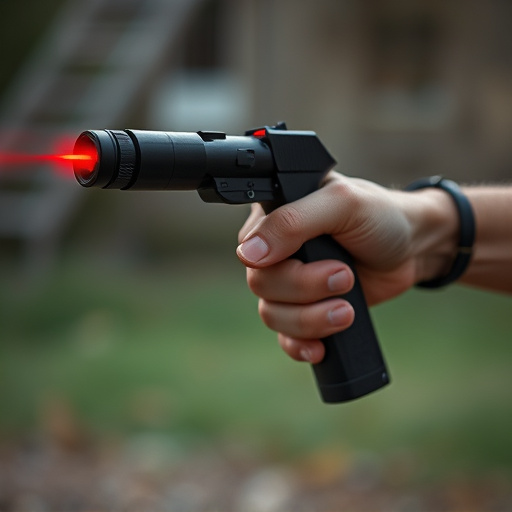Bear spray, with its up-to-30-foot range and capsaicin formula, is a vital tool for outdoor enthusiasts in bear habitats, enhancing safety against aggressive bears. Selecting high-concentration (2%-4%) pepper spray with long reach, consistent pattern, easy trigger mechanism, and weather resistance is key. Mastering the best pepper spray self-defense techniques, like aiming low at eyes, nose, mouth, and angling away from attacks while maintaining nozzle direction on the threat, significantly improves deterrence chances during outdoor activities in known bear areas. Regular maintenance, including license checks, local regulations adherence, and expiration date reviews, ensures peak effectiveness when needed.
“Staying safe during encounters with wild bears is crucial, especially in their habitat. Bear spray has emerged as a popular and effective defense mechanism against these powerful animals. In this article, we’ll explore the best pepper spray self-defense techniques and how they can provide a critical line of protection. Understanding bear behavior and the science behind bear spray’s effectiveness will empower you to make informed decisions for your safety in the wild. Let’s delve into the essential aspects of preparing for, and navigating, potential bear attacks.”
- Understanding Bear Spray and Its Effectiveness
- Choosing the Right Pepper Spray for Self-Defense
- Effective Techniques to Use in Case of an Attack
Understanding Bear Spray and Its Effectiveness
Bear spray, also known as pepper spray designed for wildlife defense, is a powerful tool for self-defense against bear attacks. It’s an essential addition to any outdoor enthusiast’s emergency kit when venturing into bear country. Unlike traditional pepper spray used for human self-defense, bear spray formulations are designed to deter bears of various sizes and can be effective at distances up to 30 feet (9 meters). The active ingredient typically includes capsaicin, the same compound that makes chili peppers spicy, coupled with other chemicals to enhance its effectiveness against animal sensations.
When faced with an aggressive bear, spraying it with bear spray can create a temporary blind spot and cause the animal to flee. It’s crucial to understand the best pepper spray self-defense techniques, like aiming for the bear’s face and eyes, which are sensitive areas. Proper usage involves holding the canister upright, pulsing the trigger in short bursts, and backing away slowly while the spray takes effect. While not a guarantee of complete protection, bear spray offers a valuable layer of safety during outdoor activities in known bear habitats.
Choosing the Right Pepper Spray for Self-Defense
When considering bear spray as a defense mechanism against animal attacks, it’s crucial to understand that not all pepper sprays are created equal. The best pepper spray for self-defense should meet specific criteria tailored to potential outdoor encounters. Look for high concentrations of capsaicin, the active ingredient responsible for the burning sensation, typically measured in parts per million (ppm). A concentration of 2% to 4% is recommended for maximum effectiveness against bears. Additionally, consider the spray’s range and duration; a can with a longer reach and a consistent spray pattern will offer better protection at a safe distance.
The ideal bear spray should also be designed with ease of use in mind. Streamlined triggers, ergonomic designs, and weather-resistant construction ensure reliable performance during unpredictable outdoor conditions. Reputable brands often include user instructions focused on proper technique, emphasizing the importance of aiming low, close to the animal’s face, for maximum impact. Following best pepper spray self-defense techniques, such as those provided by experts in wilderness safety, can significantly enhance your chances of deterring an attack and ensuring a safer outdoor experience.
Effective Techniques to Use in Case of an Attack
In the event of an attack, the best pepper spray self-defense techniques involve a combination of strategic movements and awareness. First, identify your target areas—eyes, nose, and mouth—and aim for them directly. The goal is to create a barrier between you and the attacker by spraying in their face, temporarily blinding and disorienting them. Rapidly move at an angle away from the attack while keeping the nozzle aimed towards the threat. This technique allows you to maintain distance and increase your chances of escape.
Remember, consistency is key. Practice these movements beforehand so that in a high-stress situation, your body reacts instinctively. Keep bear spray readily accessible, ensure it’s properly licensed, and familiarize yourself with local regulations regarding its use. Regularly inspect the spray for expiration dates and proper functioning to guarantee maximum effectiveness when needed.
Bear spray can be a powerful tool for self-defense against animal attacks, offering both a deterrent and a means to escape. By understanding its effectiveness and choosing the right pepper spray, you’re taking a significant step towards ensuring your safety in bear country. Mastering the best pepper spray self-defense techniques will further enhance your ability to navigate and protect yourself during potential encounters. Remember, preparation and knowledge are key to staying safe while enjoying the outdoors.
